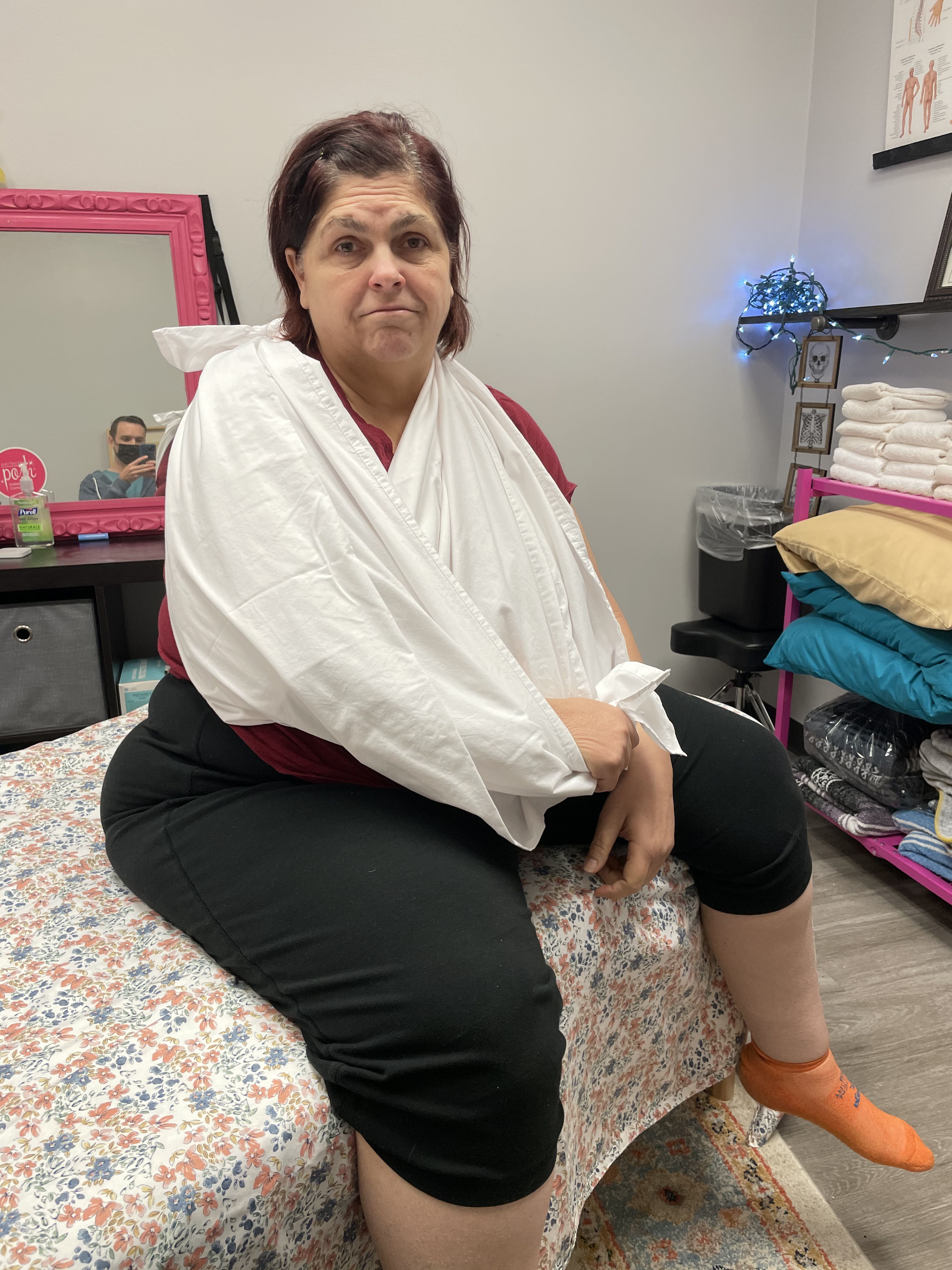Four ways massage helps 'thaw' frozen shoulders
About a year ago, I tripped and fell face first onto my living room floor dislocated my right shoulder in the process. It hurt like H-E-double hockey sticks. Diagnosis: severe shoulder strain. All these months later, my shoulder is at 85-90% range of motion. But, that being said, every day the joint zings me with a loud pop or sharp stabbing pain when I go beyond my 'new' normal range of motion.
Effectively, I'm dealing with a frozen shoulder.
What is frozen shoulder?
Frozen shoulder, officially known as adhesive capsulitis, typically shows itself as pain and stiffness in the shoulder joint.
The shoulder joint is made up of bones, ligaments, and tendons that are all encased in the joint capsule. This is a fancy way to say that all that connective tissue is covered by more connective tissue like a sack or blanket. When the joint capsule becomes thick and tight and restricts movement of the arm at the shoulder, that’s frozen shoulder.
One of the most frustrating aspects of frozen shoulder is that we don’t know exactly what causes it. Frozen shoulder most often occurs as a result of limited mobility after surgery, traumatic injury from an accident, or a repetitive use injury. It’s most common in people over 40 years old, especially women, and is more likely to occur in people with diabetes. But sometimes, it just happens with no traceable cause.
Frozen shoulder develops slowly, over a period of months or sometimes years, and is divided into three stages, freezing, frozen, and thawing. Let’s take a closer look at all three.
Freezing
In the freezing stage, you start to become aware of the pain, especially when elevating your arm. At this point, you probably shrug it off or chalk it up to “something you did” or “sleeping funny.” You might start to modify your shoulder and arm movements to avoid causing pain.
Unfortunately, this only makes things worse because restricting movement decreases range of motion in the joint, causing stiffness and more pain. The freezing stage happens slowly but can feel like ‘all of a sudden’ you aren’t able to put your hands in your back pockets or brush your hair.
Frozen
Once you reach the frozen stage, pain may start to decrease, but the shoulder may become stiffer, and using it becomes more difficult. This leads to your body compensating for the lack of mobility causing the muscles surrounding the shoulder to become impaired. In particular, the Supraspinatus, Infraspinatus, Teres Minor and Subscapularis, more commonly known as the “rotator cuff” muscles.
However, these are not the only muscles that are affected. The deltoid muscles, latissimus dorsi, pectoralis muscles, as well as serratus anterior, can also become compromised.
Thawing
The final stage of thawing happens when the range of motion in the shoulder begins to improve. there is no tempo or pattern for when a frozen shoulder begins to thaw and every individual reaches this stage at their body’s own pace. And although movement and range of motion begin to improve, dysfunction of the supporting muscles can still feel painful.
The whole cycle of frozen shoulder can last 6 months to 2 years.
Treating Frozen Shoulder
With true frozen shoulder, treatment plans can vary greatly from person to person.
Physical therapy is typically the first effort in managing frozen shoulder. When started in the freezing stage, physical therapy can maintain any remaining mobility and improve mobility once the joint is in the thawing and recovery stage.
Massage therapy can be helpful with any related function freezing of related muscles.
- Myofacial release, sometimes referred to as Graston technique or muscle scrapping, brings ease and movement into restricted muscles. By working across the muscle's fibers, this technique begins to slowly pull apart muscle adhesions much like pulling apart tangled wires or necklaces.
- Slow and specific soft tissue work to the shoulder and contributing muscles, as well as passive range of motion, can improve the effectiveness of physical therapy exercises and help reduce pain. But this type of slow and specific work can sometimes cause some momentary discomfort. It is especially important to communicate with your massage therapist when the pain you're experiencing is no longer tolerable.
- Stretching not only relieves pain; it also adds pliability and lubrication to joints which fuels the healing process. Muscle memory is a thing and passive/assisted stretches act as a trigger to the muscle's past funtionality.
- Post massage movement is also key to working through frozen shoulder issues. Simple exercises (or as I call them, homework) to maintain joint lubrication and strengthen the muscle groups are an essential part of the unsticking process.
An important thing to keep in mind: NEVER allow anyone to aggressively force your shoulder past its current range. Forceful manipulation can result in tearing the joint capsule and underlying structures (tendons, ligaments, etc) and any related tight musculature. Slight and tolerable discomfort at the end of a stretch, while in the hands of a gentle, mindful practitioner is reasonable. Force that can result in damage and even permanent hypermobility is absolutely not reasonable. Speak up for yourself if you are uncomfortable, physically or otherwise, and walk away from any practitioner who is not respectful of your pain and boundaries.
Massage therapy can also be fantastic for the muscles in the lower arm and surrounding structures that may tighten up as a result of the restricted shoulder.
If you’re interested in exploring how massage can be helpful as supportive therapy to other treatments or as a means to help reduce pain give me a call at 713-391-0891 or email me at marcy@connect-massage.com to discuss your options.

Me looking miserable after dislocating my shoulder after falling in my house. Dr. Adam pulled off an amazing sling using one of my massage sheets. He's the best.
Sources:
https://www.mayoclinic.org/diseases-conditions/frozen-shoulder/symptoms-causes/syc-20372684
https://www.painscience.com/tutorials/frozen-shoulder.php?
